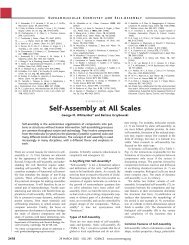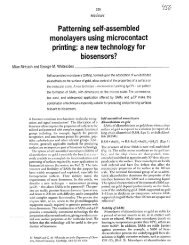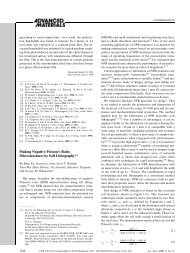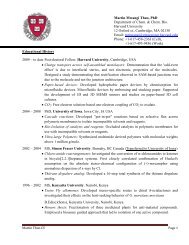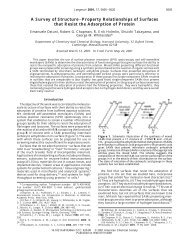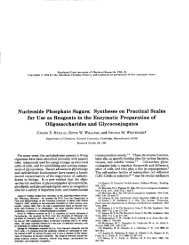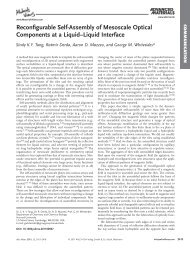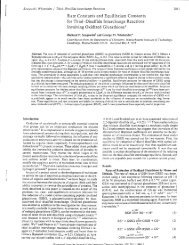Self-Assembled Monolayers of Thiolates on Metals as - Whitesides ...
Self-Assembled Monolayers of Thiolates on Metals as - Whitesides ...
Self-Assembled Monolayers of Thiolates on Metals as - Whitesides ...
Create successful ePaper yourself
Turn your PDF publications into a flip-book with our unique Google optimized e-Paper software.
1110 Chemical Reviews, 2005, Vol. 105, No. 4 Love et al.<br />
gl<strong>as</strong>s tends to produce island-textured films when<br />
their thickness is less than ∼100 nm. Depositi<strong>on</strong> <str<strong>on</strong>g>of</str<strong>on</strong>g><br />
a primer (e.g., Ti, Cr, Ni) promotes the formati<strong>on</strong> <str<strong>on</strong>g>of</str<strong>on</strong>g><br />
a mostly c<strong>on</strong>tinuous metal film structure <strong>on</strong> a substrate<br />
such <strong>as</strong> gl<strong>as</strong>s for thicknesses >∼5-10 nm, but<br />
the primers tend to diffuse through the overlying<br />
metal film to the surface over time. 193 “Blooming” <str<strong>on</strong>g>of</str<strong>on</strong>g><br />
the primer is a problem because chromium and nickel<br />
are toxic to cells adherent to the SAM and b<strong>on</strong>ding<br />
<str<strong>on</strong>g>of</str<strong>on</strong>g> sulfur to alloy surfaces is not understood. The<br />
presence <str<strong>on</strong>g>of</str<strong>on</strong>g> admetal impurities such <strong>as</strong> tin can also<br />
lead to cell death, and therefore, stringent cleaning<br />
<str<strong>on</strong>g>of</str<strong>on</strong>g> the gl<strong>as</strong>s substrates should be carried out for<br />
studies <str<strong>on</strong>g>of</str<strong>on</strong>g> this sort. Titanium does not seem to affect<br />
the viability <str<strong>on</strong>g>of</str<strong>on</strong>g> the cells and is the adhesi<strong>on</strong> layer <str<strong>on</strong>g>of</str<strong>on</strong>g><br />
choice for those systems. Chemical primers such <strong>as</strong><br />
3-aminopropyl-trimethoxysilane provide an alternative<br />
method for promoting the formati<strong>on</strong> <str<strong>on</strong>g>of</str<strong>on</strong>g> c<strong>on</strong>tinuous<br />
films <str<strong>on</strong>g>of</str<strong>on</strong>g> gold or other noble metals <strong>on</strong> substrates<br />
such <strong>as</strong> gl<strong>as</strong>s or silic<strong>on</strong>; 194 thermal annealing <str<strong>on</strong>g>of</str<strong>on</strong>g> films<br />
deposited <strong>on</strong> chemically modified substrates can<br />
incre<strong>as</strong>e the grain sizes (from ∼50-100 to ∼200-<br />
500 nm diameter) and the degree <str<strong>on</strong>g>of</str<strong>on</strong>g> crystallinity<br />
(Figure 2d). 187 Whatever the method <str<strong>on</strong>g>of</str<strong>on</strong>g> preparati<strong>on</strong>,<br />
the optical properties <str<strong>on</strong>g>of</str<strong>on</strong>g> so-called “transparent” gold<br />
thin films are complex and depend sensitively <strong>on</strong> the<br />
nature and evoluti<strong>on</strong> <str<strong>on</strong>g>of</str<strong>on</strong>g> their granular structure<br />
during the course <str<strong>on</strong>g>of</str<strong>on</strong>g> an experiment. 195<br />
An excellent quartz-substrate-supported gold thin<br />
film for studies <str<strong>on</strong>g>of</str<strong>on</strong>g> SAMs by SPM is provided by a<br />
flame annealing protocol. The method uses brief<br />
exposure <str<strong>on</strong>g>of</str<strong>on</strong>g> a supported film to the flame <str<strong>on</strong>g>of</str<strong>on</strong>g> an<br />
oxygen-hydrogen torch. 196 This method is capable <str<strong>on</strong>g>of</str<strong>on</strong>g><br />
producing excepti<strong>on</strong>al quality-nearly single-crystalline,<br />
low step density-gold surfaces for the <strong>as</strong>sembly<br />
<str<strong>on</strong>g>of</str<strong>on</strong>g> SAMs over are<strong>as</strong> <strong>as</strong> large <strong>as</strong> a few square micrometers.<br />
Thin Films <strong>on</strong> Mica. Freshly cleaved mica supporting<br />
a thin film <str<strong>on</strong>g>of</str<strong>on</strong>g> metal is a comm<strong>on</strong> substrate<br />
used <strong>as</strong> a pseudo-“single crystal” for microscopic<br />
studies <str<strong>on</strong>g>of</str<strong>on</strong>g> SAMs by scanning tunneling microscopy<br />
(STM) or atomic force microscopy (AFM). 197,198 Gold<br />
films grow epitaxially with a str<strong>on</strong>gly oriented (111)<br />
texture <strong>on</strong> the (100) surface <str<strong>on</strong>g>of</str<strong>on</strong>g> mica. The films usually<br />
are prepared by thermal evaporati<strong>on</strong> <str<strong>on</strong>g>of</str<strong>on</strong>g> gold at a rate<br />
<str<strong>on</strong>g>of</str<strong>on</strong>g> ∼0.1-0.2 nm/s <strong>on</strong>to a heated (400-650 °C) sample<br />
<str<strong>on</strong>g>of</str<strong>on</strong>g> mica. The grain sizes <str<strong>on</strong>g>of</str<strong>on</strong>g> these films are ∼1000 nm<br />
with flat (111) terraces <str<strong>on</strong>g>of</str<strong>on</strong>g> ∼100 nm in width.<br />
A method called template stripping can generate<br />
surfaces with roughness




